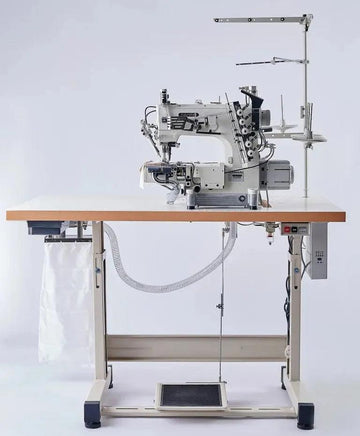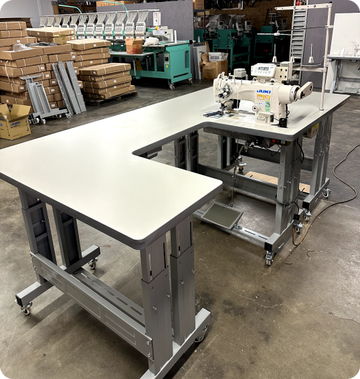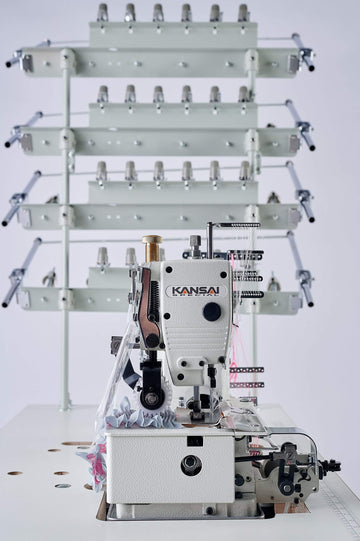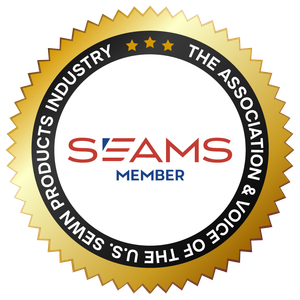Industrial sewing machines have always been a critical part of mass production. Unlike domestic sewing machines, their industrial counterparts are designed for more complicated tasks, faster speeds, and longer working hours. Finding the right equipment can be hard, regardless of your experience behind the needle. This guide can provide a better understanding of how to operate high-speed sewing machine.
What is an Industrial / High-Speed Sewing Machine?
An industrial sewing machine is a mechanical or electromechanical device designed for high-speed operations in professional settings. It can handle heavy-weight materials that require longer stitches. Many industries rely on this type of sewing machine due to its high efficiency and durability. Here are the main types of industrial machines:
-
Straight stitch machines create basic stitches in fabric, perfect for standard sewing tasks such as seaming, topstitching, hemming, and edge stitching.
-
Binding machines attach binding tape or fabric strips to the edges of garments, upholstery, or other textile products in order to create a neat finish.
-
Overlock (serger) machines trim fabric edges and create strong, clean seams in garments.
-
Coverstitch machines specialize in hemming and binding, perfect for stretchy fabrics like knits and sportswear.
-
Buttonhole and button sewing machines are automated machines that attach buttons and create buttonholes, mainly on thick fabrics.
The variety of sewing machines may be confusing, especially for beginners. Learn how to use an industrial sewing machine based on the necessary functionality.
Before You Start: Safety and Setup
Automated sewing machines have changed traditional sewing with advanced technology. They may not be the most dangerous machines, but they still have safety precautions for users. The most obvious risk is the moving needle that you are feeding your fabric through. It’s in your very best interest to keep your fingers and hair a safe distance away from the needle. Also, focus on what you are doing to prevent even a simple slip of the hand.
To get your industrial sewing machine ready, follow these steps:
-
Thread the machine. Insert the thread into the holder to ensure it goes through each tension slot. Thread the needle from front to back and from back to front.
-
Check the tension. Make sure you know where to find the tension regulator to produce accurate stitches. According to the basic rule of thumb, set it around "3". Other modifications are still possible, depending on the type of fabric you use.
-
Wind the bobbin. Thread it along the machine's top and set it on the bobbin stand. Start winding the bobbin, ensuring the thread is properly wound. The presser foot can help you wrap the thread onto the bobbin.
-
Check bobbin position. Make sure that the thread smoothly goes through the tension slots. Insert the bobbin into the casting and ensure it stays in one place.
-
Catch the bobbin thread. Bring the needle downward by turning the flywheel. Once done, you're ready to make the first stitch!
Don’t forget to adjust the machine speed. Basic sewing machines have a foot pedal, allowing you to control the speed through the applied pressure. More complex machines have a speed control slider or dial, enabling you to reach the highest speed. Advanced machines have programmable speed settings, depending on the task at hand.
How to Operate a High-Speed Sewing Machine
Learning how to sew with an industrial machine ensures high efficiency. To start operations, find the power switch on the right side or base of the machine, and turn it on. Check the foot pedal that controls the sewing speed. The more pressure you apply, the faster the machine runs. Practice applying gentle, steady pressure for consistent stitches. The handwheel, located on the side, should always be turned toward your side. Manually raise or lower the needle when placing a piece of fabric or finishing a stitch.
Adjust stitch length and tension to achieve flawless seams. Adjust the stitch length to receive shorter stitches for light fabrics and longer stitches for heavy materials. Set thread tension to make the upper and lower threads meet neatly in the middle of the fabric without looping or puckering.
Start and stop correctly. Place the fabric under the presser foot, lower it, and begin sewing slowly. Each time you make a stop, release the foot pedal, raise the needle using the handwheel, and lift the presser foot before removing the fabric.
Working on a high-speed sewing machine is not hard. The main point is to have all factors under control before stitching at high speed.
Read Also: Industrial Sewing Machine Brands
Basic Sewing with an Industrial Machine
To learn how to sew on an industrial sewing machine, practice on scrap fabrics. It is the best way to get comfortable with the commercial machine before starting real projects. Use old pieces of fabric to master threading and tension control techniques until you achieve even seams. Once done, focus on straight stitching, required for basic sewing tasks. Place the fabric under the presser foot, align it with the seam on the needle plate, and use the foot pedal to start sewing slowly. Make sure to keep the fabric straight and let the feed dogs pull it through without excessive pressure.
Backstitching for reinforcement is crucial for securing seams. To backstitch, sew a few stitches forward, hold the reverse lever or button, and stitch back over those stitches. Use forward stitching to complete the seam and secure your work.
For curves, move the fabric with both hands while turning it slightly as the needle moves to create a line. Avoid sharp pulls, which can distort the seam. For corners, stop with the needle down in the fabric, lift the presser foot, move the fabric in the new direction, lower the foot, and continue sewing.
Mastering these basics can help you develop better speed control and build sewing confidence. With sufficient practice, you can be prepared for more advanced sewing projects.
Tips for Beginners
Understanding the features and functions of industrial sewing machines is crucial for delivering an excellent result in professional settings. Here are a few tips to help you manage the sewing process even more effectively:
-
Place your machine on a sturdy cabinet or table. Use a muffling mat to minimize the vibration and the noise.
-
Keep the pieces of fabric together before you resume sewing. Slowly increase speed to maintain control of the process as you sew faster.
-
Take pins out of the fabric as you go. Sewing over pins can cause damage to the machine and fabric.
-
Select the stitch length based on the fabrics you use. Thinner fabrics usually require shorter stitches, while thicker materials require longer stitches to deliver good seams.
-
Secure stitches at the end of a seam to secure your work. Slow down when coming to the end of the piece so that you can reduce the stitch length and create a few stitches in reverse to cover the securing stitches.
-
Change your needle regularly to avoid thread problems and skipped stitches. A rule of thumb indicates the need to change a needle every 8 hours of active sewing.
Following these tips can guide beginners on how to use industrial sewing machines. Make sure to stay concentrated on the sewing process at any point of work.
Maintenance and Care
Industrial sewing machines are intended for mass production in professional settings. To keep these machines running smoothly, you should provide proper care. A well-maintained machine operates longer and delivers precision. Here is how you maintain a sewing machine for industrial use:
-
Ensure regular maintenance. Even if the machine works well, take it to a professional service for proper examination every 2 years.
-
Do timely cleaning and oiling. Remove dust and threads that could interrupt smooth performance. After each use, brush away debris from the feed dogs, bobbin case, and needle plate. Follow the manufacturer’s instructions for oiling key moving parts to reduce friction and prevent wear.
-
Check tension and alignment. If stitches are too loose or tight, adjust the thread tension and test on scrap fabric until both the upper and lower threads lock neatly. Bent or dull needles should be replaced immediately to maintain consistent stitches and keep fabrics safe.
-
Perform regular inspections. Look for loose screws, worn belts, or unusual noises that may indicate mechanical problems. Schedule regular maintenance to keep your vehicle in excellent condition.
Listen to your machine. Don’t ignore any signs of an issue. If you hear any unusual noise, you should get your machine checked by professionals.
Conclusion
Learning how to sew using commercial machines may seem daunting, especially for beginners. With clear industrial needs, everyone can master the sewing process in a short time. In South El Monte, Los Angeles, California, you can find many professional brands offering functional models within any price range. Don’t rush to make the final choice! Make sure to check the available components, features, functions, and warranty terms. Contact local retailers to buy a sewing machine that meets your commercial needs.









